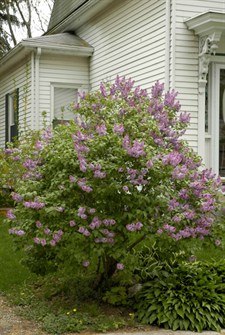...or overplanted by design?
On the road, we often entertain ourselves by looking at
landscapes. We admire nifty plants, pick out problem symptoms,
comment on pruning, and sometimes debate the relative merits of one
or another design.
Here's a bed in a landscape we debated recently. Our discussion
ranged across four perspectives:
Unintentional overplanting
By our standards, this bed is overplanted.
Here is a diagram of what's in the bed now and each plant's
potential size. For five years from
now, check the bottom of this page.


So, one of us offered no objections to the other's first
statement, "Well, that's going to be a jungle." Not so, the
statement's continuation, "and the designer ought to be shot."
"Hey, maybe the designer's a novice with no idea how big all
those plants are going to get."
Right: The Japanese maple's going to get THAT big?! For help
predicting a plant's eventual size and how quickly it will reach
that, see Predict Size.
Below, left: Dwarf lilac (Syringa meyeri), as planted
about 30"
tall...
Below, right: ...and as they may be 5 years later.


Below, left: Gold Mop falsecypress (Chamaecyparis
pisifera 'Gold Mop') as planted, about 12" tall...
Below, right: ...and as they may be five years later.


Below, left: New gardeners who don't recognize this young
cutie as a standard spruce are in for surprise. After about 5 years a sheared evergreen
completes its ungainly transition to
normal habit, and along the way it really takes off,
size-wise.
Below, right: We don't consider the herbaceous perennials, such as
this ornamental grass, to be major players in this bed. The grass
and daylilies will most likely be squeezed out or shaded into
insignificance by the tree and shrubs.


"Well, maybe the designer didn't know. Or maybe eventual size
didn't matter. The goal might've been an immediately full look.
Maybe they're selling the house."
"So they're going to stick the next owner with a jungle!"
"Maybe. Or maybe they're planning to use some of the plants as
they grow, move them out to other places.
Maybe they got a good deal, 3 for the price of one. So maybe it
could be thinned out as things grow. Or pruned."
"Humph. Tell me how you'd do that."
We did, ending with two workable futures for the bed and one
certainty -- that there's no way to simply let this group of plants
mature together.
If you're someone who's just discovered an overplanting you
never ordered, you, too, may be able to save it by looking at our
two
possible futures for this bed.
More about why overplanting happens and how to avoid it in
What's Up 156.
A stake in another issue

One last issue came up, not design related but something that
could ruin this design by killing its main player. That is, the
Japanese maple has been staked. The tree must be un-staked, and
soon.


Below: The bare spots and loss of gold color we mention in
the diagram above. Typical of crowded, shaded threadleaf
falsecypress.
